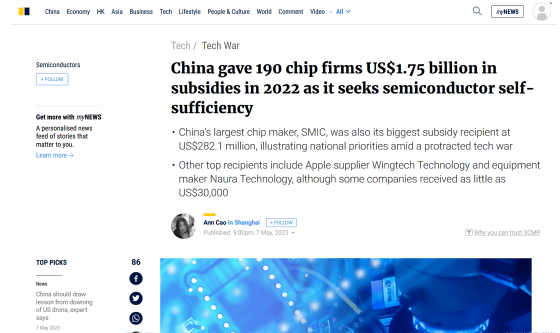The Chinese government is aiming for ``semiconductor self-sufficiency'' by injecting subsidies of more than 200 billion yen annually to domestic semiconductor-related manufacturers

The United States has strict
China gave 190 chip firms US$1.75 billion in subsidies in 2022 as it seeks semiconductor self-sufficiency | South China Morning Post
https://www.scmp.com/tech/tech-war/article/3219697/china-gave-190-chip-firms-us175-billion-subsidies-2022-it-seeks-semiconductor-self-sufficiency

China and the United States, which compete for the position of the world's largest economic power, have deepened their confrontation in recent years, and the United States government has criticized China for high-performance semiconductors and manufacturing on the grounds of 'protecting national security and foreign policy interests.' We are tightening regulations, such as prohibiting the export of technology. In response, China has taken countermeasures such as filing a lawsuit against the United States with the World Trade Organization (WTO) , which aims to promote free trade. increase.

The South China Morning Post reports from Chinese media ijiwei, which summarizes data obtained from financial data provider Wind, that the Chinese government will invest more than 12.1 billion yuan in 2022 alone for 190 domestic listed semiconductor companies. reportedly providing subsidies for
Of the 190 subsidized companies, the top 10 companies received 5.46 billion yuan (about 106.5 billion yen), which is 45% of the total, and this amount is also confirmed in the documents submitted by the top 10 companies. It is said that there is. It should be noted that ijiwei's report only covers companies listed on the Shanghai Stock Exchange or Shenzhen Stock Exchange, and many other unlisted companies also receive government support through loans and direct investment, South said. China Morning Post says.
The company that received the most subsidies from the government was China's largest semiconductor
Other top 10 subsidy companies include Wingtech Technology , known as Apple's supplier for manufacturing chips and mobile terminals, and Yangtze River memory (YMTC) supplier Naura Technology , which is subject to sanctions by the US Department of Commerce. And so on, all of which have received subsidies of 100 million yuan (about 1.9 billion yen) or more. However, the amount of subsidy varies greatly depending on the company, and it seems that the subsidy received by the lowest-ranked company included in the report was only 200,000 yuan (about 3.9 million yen).

It is not only the central government that subsidizes semiconductor companies in China, but also many local governments. After the end of 2022, many local governments, such as
``This sum shows how companies are benefiting from China's self-sufficiency in semiconductors as the technology war with the United States intensifies,'' said the South China Morning Post. I was.

Related Posts:
in Hardware, Posted by log1h_ik






